The premium of MSTR is a "crypto reactor," which drives the equity value of MSTR through a recursive loop.
Authors: Patrick Bush, Matthew Sigel
Compiled by: Deep Tide TechFlow
We conducted an in-depth analysis of MicroStrategy (MSTR), viewing it as a structural leverage Bitcoin (BTC) investment tool, focusing on its net asset value (NAV) premium, regulatory positioning, and the flexibility of its capital structure, all of which drive its investment opportunities and risks.
Please note that VanEck holds relevant positions in Bitcoin, MSTR, STRK, and STRF.
Four Core Insights:
MSTR stock is a leveraged Bitcoin alternative: MSTR's stock behaves similarly to a call option on Bitcoin. Its strategy is to buy more BTC when Bitcoin prices rise by issuing stock and debt. This structure brings asymmetric upside potential and is highly sensitive to BTC price fluctuations, making MSTR a popular alternative to directly holding Bitcoin.
MSTR trades at a significant premium to net asset value (NAV): We calculated that MSTR's trading price reflects a premium of +112% compared to the fair value of its Bitcoin holdings and core software business. This premium arises from market expectations of future BTC holding growth, regulatory advantages, and speculative positions.
MSTR's premium is a "crypto reactor": This premium drives MSTR's equity value through a recursive loop: volatility and Bitcoin exposure attract investor capital, leading to more BTC accumulation, which further amplifies the premium.
Convertible securities add flexibility but also increase risk: MSTR's convertible bonds and preferred stock (especially STRK and STRF) offer different levels of yield and BTC exposure, but also introduce complexity, asymmetric downside risk, and sensitivity to volatility. Among these, the convertible bonds maturing on March 15, 2030, have the largest exposure to MSTR, but even these instruments are highly dependent on BTC performance and the sustainability of the premium.
Strategy (MSTR) accounts for nearly one-third of the pure crypto equity market capitalization and represents 10% of the Market Vector Global Digital Assets Equity Index (MVDAPP). Therefore, for investment managers looking to achieve excess returns (alpha) through digital asset transformation, whether to include it in their portfolios becomes a key consideration.
The debate over the pros and cons of holding MSTR, directly holding Bitcoin (BTC), or leveraging BTC continues, with its complex capital structure further intensifying this discussion. This complexity also includes convertible bonds and equity instruments issued by Strategy, including high-yield convertible preferred stock (STRK) and higher-yield non-convertible preferred stock (STRF).
In this article, we analyze Strategy's capital structure and assess the advantages and disadvantages of holding positions in its equity or debt system. We believe that MSTR common stock is a superior investment choice compared to other options for the following reasons:
Maximum exposure to Bitcoin
Simplicity of the investment strategy
Optimal risk/reward ratio
What is Strategy?
Strategy (formerly MicroStrategy) is an enterprise analytics software provider and the pioneer of the "corporate Bitcoin reserve" concept. In August 2020, Strategy assessed that its substantial cash reserves on the balance sheet were vulnerable to inflation in the then-low interest rate environment. Thus, Strategy's Bitcoin reserve strategy was officially launched, utilizing $250 million in cash to purchase 21,454 BTC.
By December 2020, Strategy further clarified its goal of purchasing BTC through financial means by issuing $650 million in convertible bonds. Since then, Strategy has transformed from a pure enterprise software company into a leveraged Bitcoin financial instrument. Through leverage and various forms of equity issuance, Strategy holds 2.7% of the total Bitcoin supply, which, as of the writing of this article, corresponds to a value of approximately $61 billion.
Strategy's core objective is to maximize MSTR's stock price by increasing the number of Bitcoins "backing" each share of common stock. By issuing debt or equity, Strategy increases the Bitcoin holdings per share and refers to this dynamic as "Bitcoin Yield." During periods of rising Bitcoin prices, when investor demand is strong, Strategy seizes the opportunity to increase leverage or issue more equity. Therefore, Strategy's exposure to Bitcoin and leverage is recursive, as it is expected to grow over time.
As Bitcoin appreciates, the value of Strategy's Bitcoin reserves also increases, allowing it to leverage further by issuing debt to purchase more Bitcoin. On the equity side, the Bitcoin bull market has driven the performance of MSTR common stock in the capital markets, enabling Strategy to raise funds through stock issuance to buy more Bitcoin. Ultimately, MSTR stock provides accelerated exposure that aligns with rising Bitcoin prices, with price dynamics similar to a call option on Bitcoin.
Understanding the Source of MSTR's Equity "Premium"
Currently, MSTR's common stock trades at a price above the combined total of its Bitcoin net asset value (BTC NAV) and the value of Strategy's core software business, a portion referred to as the "Premium." As of the writing of this article, MSTR's common stock trading premium is as high as +112% of the fair value of its underlying assets (Bitcoin holdings + core business). Mathematically, we define it as:

Source: VanEck Research (as of March 25, 2025)
Regarding the causes of the MSTR premium, there are many debates in the market, but we believe it is primarily driven by the following four factors:
Expectations for Strategy's future Bitcoin holdings
Limited options for investors to gain Bitcoin exposure
The advantages of leveraged exposure to Bitcoin and Strategy's leverage
Speculative behavior
The primary source of the MSTR premium is the market's expectations for Strategy's future Bitcoin holdings. The future value of Strategy's Bitcoin holdings can be estimated through the following three key factors:
The "terminal" number of Bitcoins held
The expected future price of Bitcoin
The discount rate applied to these holdings
The premium of MSTR stock largely reflects the market's recognition of the company's future continued purchases of Bitcoin. A positive premium indicates that the market expects the value of each Bitcoin to continue to grow, while also reflecting the discounted value of Bitcoin's future price.
The second factor can be described as a "regulatory premium," stemming from structural limitations in the investment environment. Many institutional and individual investors are unable to directly purchase Bitcoin due to regulatory restrictions, investment regulations, distribution bottlenecks, or a lack of secure custody solutions.
Unable to access capital-efficient and leveraged Bitcoin investment tools, they choose to invest in MSTR. Additionally, many jurisdictions have unfavorable tax treatment and capital holding requirements for Bitcoin, making investors more inclined to choose publicly traded stocks like MSTR as alternative tools. As common stock, MSTR also has financial advantages as collateral. These investor restrictions make MSTR an attractive proxy for Bitcoin exposure, especially for those unable to directly access this asset class.
The third factor contributing to the MSTR premium is the market's recognition of Michael Saylor's (founder of Strategy) ability to use financial leverage. Saylor has demonstrated the ability to raise substantial capital at low interest rates, while his corporate structure has shown resilience during downturns in the Bitcoin market. Unlike typical margin traders, Saylor can withstand losses and maintain long-term positions. During parts of 2022 and 2023, despite Strategy's equity deficit reaching hundreds of millions of dollars, MSTR's market capitalization remained at several billion dollars, reflecting investor confidence in Strategy's long-term leverage structure.
MSTR's unique dynamics have caused its 30-day historical volatility to soar to ~113%, far exceeding Bitcoin's ~55%. Overall, MSTR stock provides investors with a convenient way to gain leveraged Bitcoin exposure through the publicly traded stock market. The premium is a major contributor to MSTR stock's volatility and performance. By breaking down the weights, correlations, and volatility of the MSTR portfolio (Bitcoin + core business + premium), we find that the premium contributes 96.5% to total returns and approximately 87.5% to volatility.
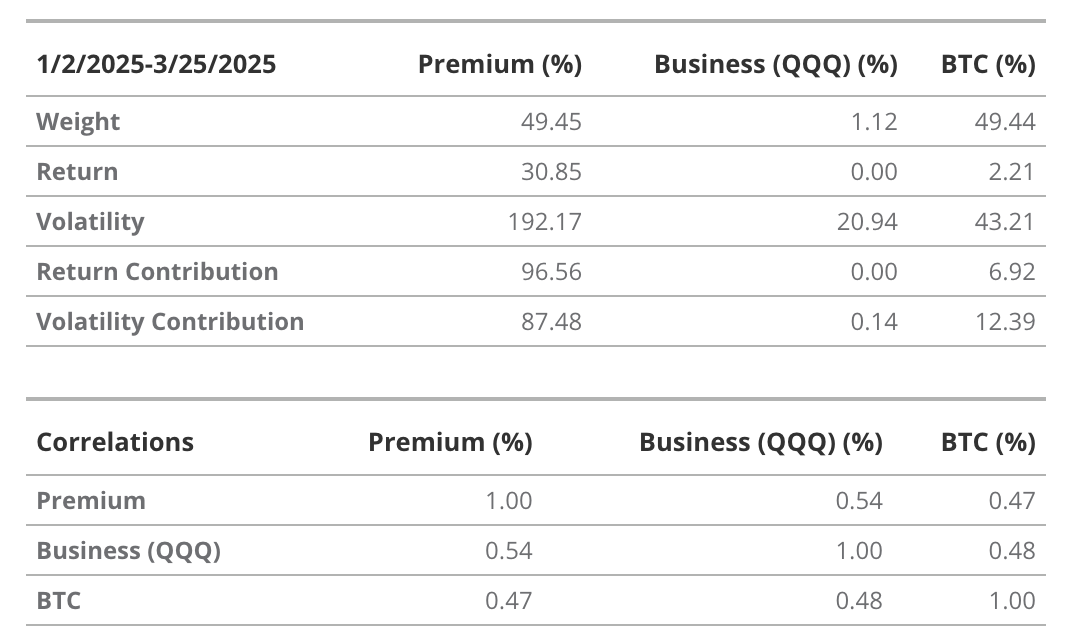
We use QQQ (Invesco's Nasdaq 100 ETF) as a proxy for exposure to the technology sector, particularly targeting large software and cloud computing companies, to reflect the characteristics of MSTR's core business.
Source: VanEck Research (as of March 26, 2025). Past performance is not indicative of future results. The information, valuation scenarios, and price targets in this article do not constitute financial advice and do not represent any call to action, buy/sell recommendations, or predictions of Bitcoin's future performance. The actual future performance of Bitcoin is unknown and may differ significantly from the hypothetical results presented in this article. Additionally, the scenarios listed in this article may not cover all risks or other factors that could hinder performance. These are merely simulated results based on our research, provided for illustrative purposes. Please conduct your own research and draw your own conclusions.
The fourth component of the MSTR premium stems from the speculative trading dynamics related to its volatility and capital structure. Given that the premium significantly contributes to MSTR's returns and volatility, any disruption to the core driving factors would have a substantial negative impact on MSTR's stock price. This is because Saylor uses MSTR's volatility to fund Bitcoin (BTC) purchases. As we will detail below, Saylor's preferred financing methods for purchasing BTC, in order, are: preferred stock, convertible preferred stock, convertible debt, and common stock. This order is based on the "BTC yield" available to common shareholders, which is driven by the amount of BTC corresponding to each share of common stock. For example, selling preferred stock leads to equity dilution, but the funds raised are directly converted into BTC yield for common shareholders.
These securities launched by Strategy are popular among investors because MSTR's high volatility provides numerous opportunities across various levels of its capital structure and in MSTR's options trading. In fact, Strategy is able to maintain low interest rates on its convertible debt precisely because MSTR's volatility makes the option component of the convertible debt highly valuable. It can be said that Strategy prices these option values at lower prices to attract relative value trading entities. These complex arbitrageurs engage in relative value trading through the volatility between various securities of Strategy.
Ultimately, a cyclical relationship forms between Strategy's premium and its ability to finance the purchase of more BTC. The premium is a primary source of MSTR's volatility, while the premium largely depends on Strategy's ability to finance BTC purchases. The market is willing to buy Strategy's stock precisely because its capital structure is volatile, and Strategy can be said to sell this volatility at a low price. In the first quarter 2025 earnings call, Saylor referred to this enhanced dynamic as a "crypto reactor" that can sustain for a long time.
The premium of MSTR shows a clear positive correlation with Bitcoin prices. Over the past year, its correlation coefficient with BTC has been 0.52 (T-Stat = 9), with an approximate Beta coefficient of 1.77 with BTC. This indicates that as Bitcoin prices rise, the premium tends to expand, further enhancing MSTR's stock performance. The connections between BTC prices, speculative behavior, financing ability, and MSTR valuation form a self-reinforcing loop that is central to the company's strategy.
Correlation of Premium with Bitcoin Prices
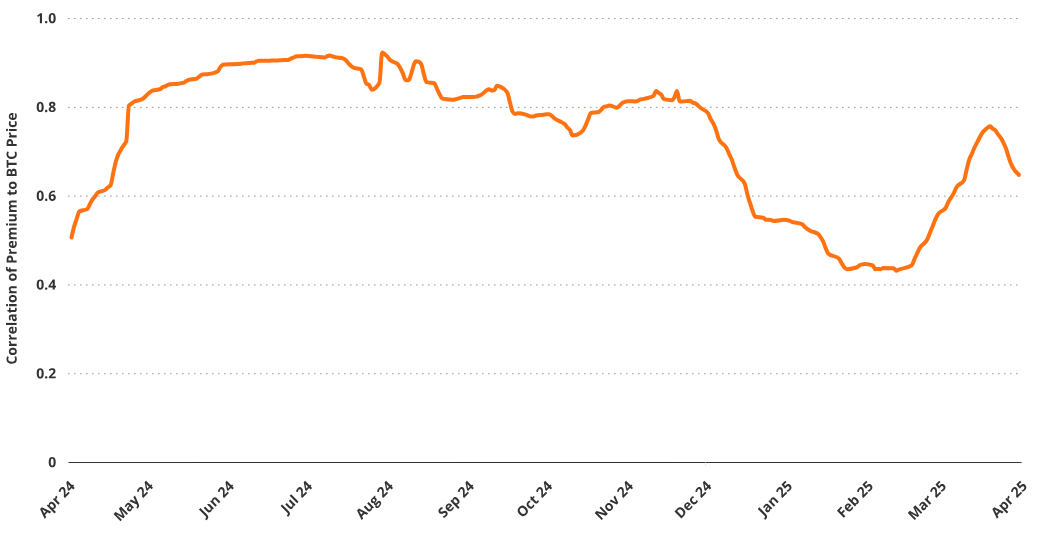
Source: VanEck Research (as of March 26, 2025). Past performance is not indicative of future results. This article does not constitute buy/sell recommendations for any securities mentioned.
Financing Bitcoin Reserve Strategy
In October 2024, Strategy announced an ambitious "21/21" capital plan, aiming to raise $42 billion for Bitcoin (BTC) purchases by selling $21 billion of MSTR stock and $21 billion of fixed-income securities by 2027. According to the initial plan, Strategy will sell $5 billion, $7 billion, and $9 billion worth of stock in 2025, 2026, and 2027, respectively. At the same time, the issuance pace of fixed-income securities will be the same, at $5 billion, $7 billion, and $9 billion. These debt issuance targets aim to maintain leverage between 20%-30%. Strategy's leader, Michael Saylor, referred to this as "Intelligent Leverage," emphasizing that it is not for speculation but to strategically acquire "dominant digital assets."
Thanks to the unprecedented crypto bull market following the launch of the 21/21 plan, as of May 2025, Strategy has sold all $21 billion of MSTR stock through its "At-the-Market" (ATM) program. In the fixed-income segment, Saylor has sold $5 billion in convertible bonds, $875 million in STRK convertible preferred stock, and $850 million in non-convertible preferred stock. In the earnings call on May 1, 2025, the company announced an expansion of its financing plan to $84 billion, which includes an additional $21 billion MSTR ATM plan, the existing $21 billion STRK ATM, and an additional $14 billion in convertible debt issuance.
42/42 Financing Plan Completed 32%

Source: Strategy, as of May 7, 2025. Past performance is not indicative of future results. This article does not constitute buy/sell recommendations for any securities mentioned.
With the current Bitcoin price around $95,000, Strategy holds 555,450 BTC. Based on calculations, Saylor's leverage ((debt + preferred stock) / market capitalization) is 9%, which is the lowest leverage Strategy has taken on since 2020. Given Saylor's current below-average leverage and preference for "convertible, unsecured, and non-recourse" debt, it is reasonable to expect that more funds will be raised through convertible debt in the future.
Financing BTC Purchases Through Volatility
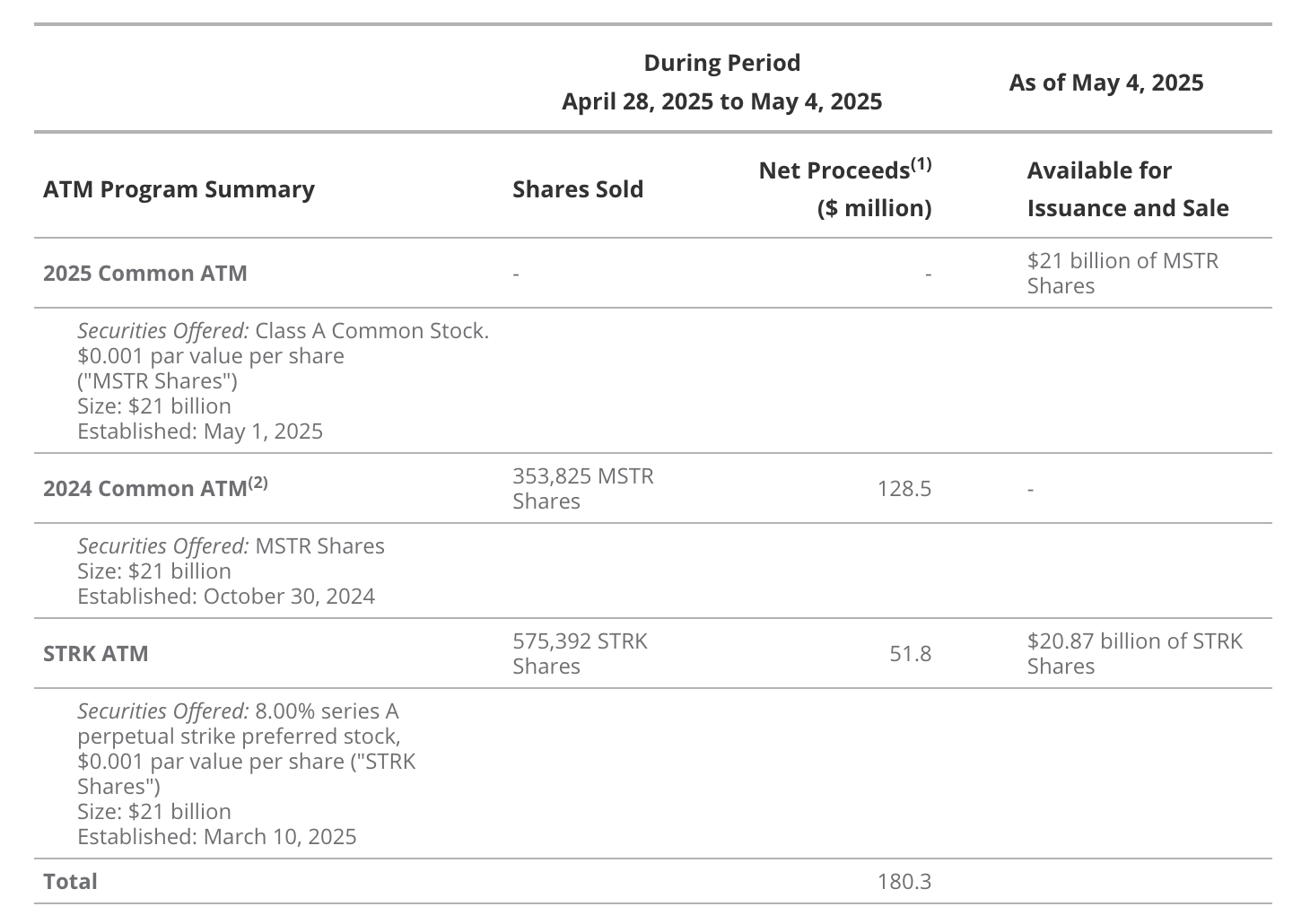
Source: Strategy, as of March 25, 2025. Past performance is not indicative of future results. This article does not constitute buy/sell recommendations for any securities mentioned.
As MSTR stock is linked to Bitcoin, it exhibits high volatility, and as Strategy provides financing for purchasing more BTC, its leverage may further increase. Most investors are generally averse to leveraging high-volatility assets like BTC, often demanding higher interest rates. Strategy addresses this issue by issuing convertible bonds and convertible preferred stock, whose embedded option characteristics provide much of their value.
Sophisticated investors favor these issuances because they allow activities such as convertible stock arbitrage. In this high-risk and complex trading strategy, experienced investors profit by buying convertible bonds and shorting MSTR stock and/or MSTR options, capitalizing on the actual volatility, implied volatility, and other components of option pricing models.
This trading dynamic helps Strategy address cash flow issues while ensuring low interest payments on its debt. Due to strong market demand for high-volatility convertible securities, Strategy can promise investors very low future interest payments. A complex balancing act forms between Strategy's capital market strategy and the market demand from potential investors.
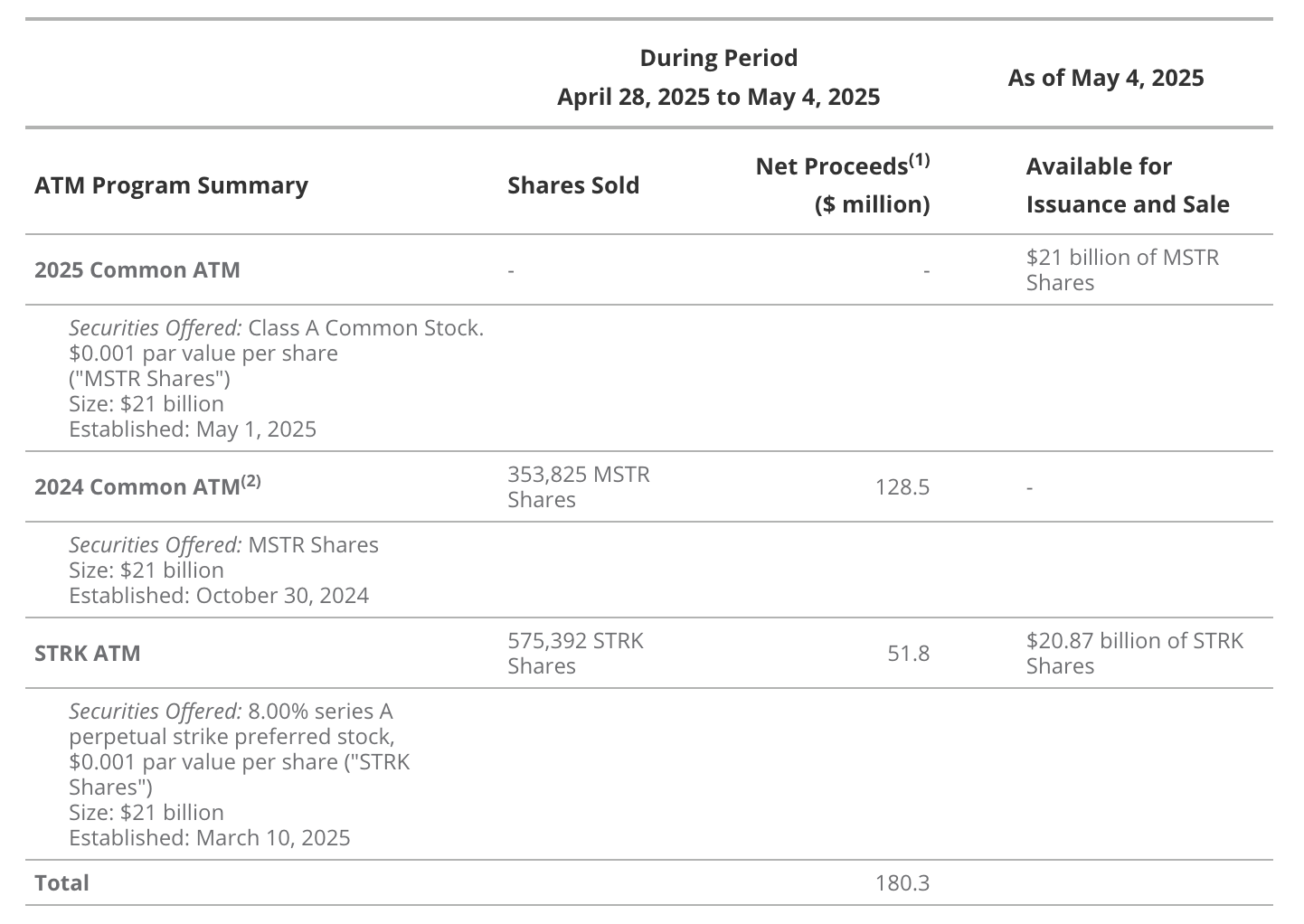
Source: Strategy, as of May 5, 2025. Past performance is not indicative of future results. This article does not constitute buy/sell recommendations for any securities mentioned.
Net income is the amount after deducting sales commissions.
The common stock ATM (At-the-Market) plan for 2024 has been largely exhausted, and its sales agreement has been terminated per the terms.
This involves Strategy pricing implied volatility, setting strike prices, and increasing redemption prices to maximize the tradability of each issuance. For example, setting a redemption price close to the market allows Strategy to set a cap on the option component of its bonds. The result is that derivatives behave more like "capped call options," with their delta potentially lower than that of ordinary call options. Choosing strike prices far out of the money can also reduce the value of the option component, thereby lowering delta. Lowering delta means reducing the number of MSTR shares (or options) needed to hedge the options in convertible bonds. Many convertible arbitrage players prefer low delta issuances because they require less capital against the trading balance sheet.
Assessing the Sustainability of Strategy's Financing
Although Strategy's core business generates some operational income, its BTC purchases through financing will create significant cash demands. Based on Strategy's documents and statements, we expect total debt to reach $13 billion by the end of 2025 (up from about $8 billion in April 2025) and $19 billion by the end of 2026. We also expect preferred stock to grow to $7.5 billion in 2025 and $15.5 billion in 2026.
By the end of 2025, we expect annual interest payments to reach $48 million, increasing to $87 million in 2026. At the same time, preferred stock (STRK) dividend payments are expected to rise from $217 million in 2025 to $904 million in 2026. We estimate these figures based on market expectations for MSTR bond coupons and preferred stock dividends. While Strategy retains the option to pay STRK preferred stock dividends in common stock, doing so would dilute the equity of existing MSTR holders by reducing the BTC per share.
With projected revenue of $475 million in 2025, Strategy relies on financing to cover its fixed-income obligations. Of course, the ability to raise new capital depends on Bitcoin prices. If Bitcoin prices continue to rise, obtaining new capital will become easier. From August 2024 to May 2025, Strategy increased its holdings from 226,000 BTC to 555,450 BTC through financing. However, during the cryptocurrency downturn from June 2022 to December 2022, Strategy could only raise $49 million and $11 million through stock and debt sales, respectively. The increased cash outflows due to new fixed-income securities issuance could pose challenges for Strategy during a bear market.
MSTR is a convex bet on BTC prices.
Investing in MSTR is somewhat akin to investing in a call option on BTC, as MSTR is leveraged sensitive (or "torqued") to BTC price fluctuations. However, it is actually more similar to attempting to dynamically replicate a call option on BTC by increasing leveraged exposure as prices rise. Strategy's approach is to increase its BTC position as financing becomes available, which typically occurs when BTC prices are rising. The risk of this strategy lies not only in price declines but also in the premium contraction caused by the collapse of financing for BTC purchases. Additionally, this strategy deploys capital at BTC peaks, which may be considered poorly timed.
The Net Gains from "Naive" Purchases Exceed Strategy's Purchases
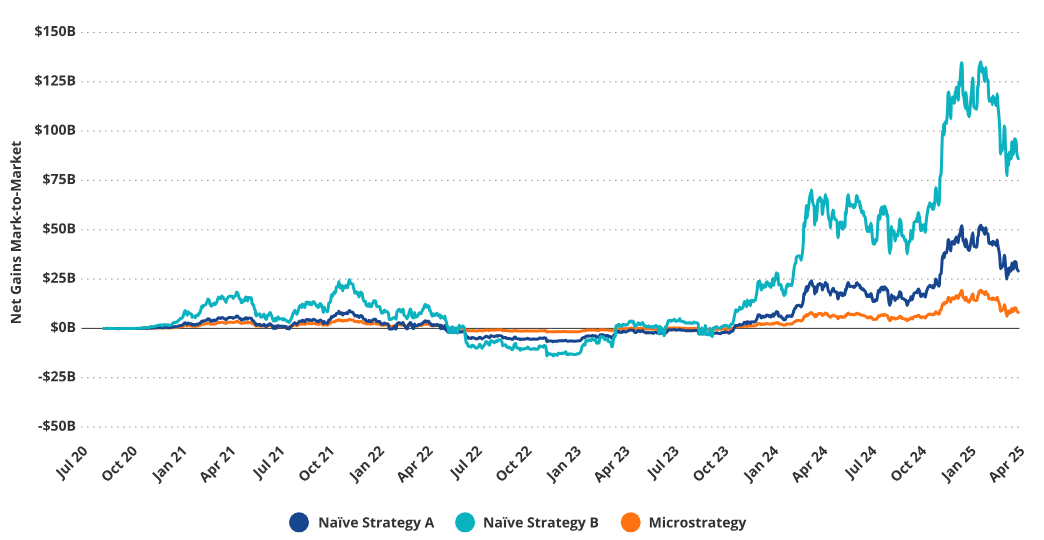

Source: VanEck Research, Strategy, as of March 26, 2025. Past performance is not indicative of future results. This article does not constitute buy/sell recommendations for any securities mentioned.
Strategy's purchases of Bitcoin (BTC) at local peaks result in "losses" compared to other strategies, as this leads to an average purchase price for BTC that is higher than if purchased randomly. Whether Strategy's purchases are the cause of these local "highs and lows" is another question. Regardless, this strategy of buying at local peaks represents a loss for shareholders compared to a "naive," randomly implemented BTC purchasing strategy. On the other hand, due to MSTR's "positive convexity," changes in Bitcoin prices can lead to a significant increase in the dollar value of BTC per share, while new financing also increases the amount of BTC held per share. Therefore, investors gain greater BTC exposure as BTC prices rise.
As an individual investor, it is nearly impossible to replicate Saylor's strategy without the "shell" of the company. While investors can see their margin balances grow by purchasing BTC futures when BTC rises, allowing them to buy more BTC, they cannot "patiently" hold this leveraged position during price declines. Futures contracts settle at market prices daily, meaning profits and losses are settled regularly, and margin calls must be met immediately during market pullbacks. If BTC's price retraces beyond their margin balance, margin traders will be forced to liquidate.
Thus, **even if a savvy trader attempts to mimic Saylor's strategy by gradually increasing their position as BTC appreciates, even a moderate *pullback* could trigger a margin call, wiping out the trader's position. This daily margin requirement makes it difficult for individual investors to replicate Strategy's long-term BTC accumulation strategy through futures. Therefore, Strategy has a significant financial advantage that allows it to operate a leveraged BTC strategy more effectively.
MSTR's Capital Strategy and Bitcoin Returns
Strategy's financial engineering increases the BTC exposure per share of common stock by adding debt and equity. This is because Strategy's core objective is to increase common stock exposure to BTC price movements. Saylor refers to the increase in the number of BTC per share as "BTC Yield." This key performance indicator (KPI) is calculated by comparing the amount of BTC held per share of common stock over different periods. As of May 2025, the year-to-date BTC yield is approximately 14% (based on issued common stock), and about 13% on a fully diluted basis. Strategy's minimum BTC yield target for 2025 is 25%. This means that the amount of BTC corresponding to every 1,000 shares of MSTR common stock will increase from approximately 1.79 BTC on May 8, 2025, to about 1.99 BTC by the end of the year.
Strategy's Bitcoin Yield Faces Challenging Prospects
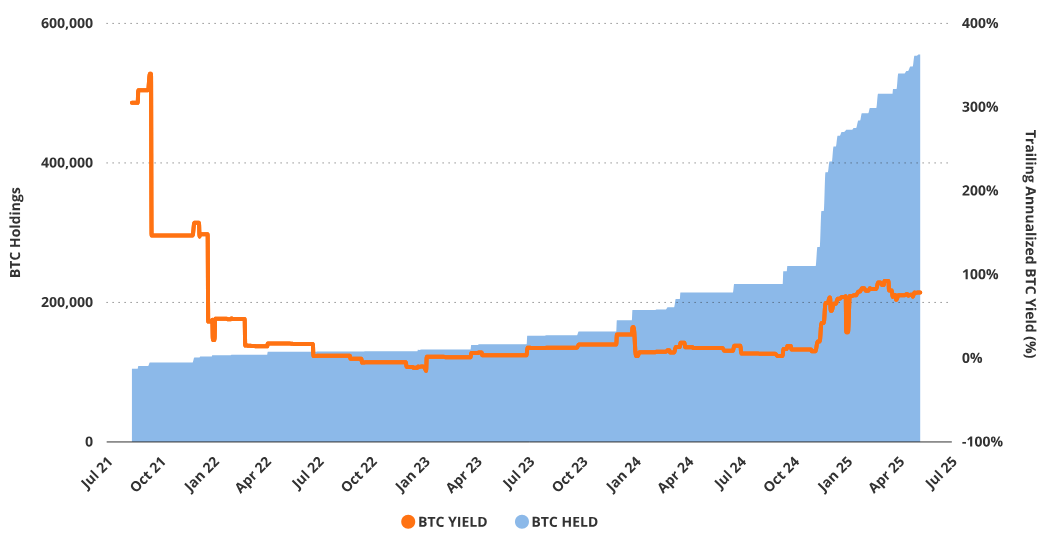
Source: Strategy, as of May 8, 2025. Past performance is not indicative of future results. This article does not constitute buy/sell recommendations for any securities mentioned.
Strategy's management team has various options for generating Bitcoin yield (BTC Yield). They can acquire Bitcoin by selling various financial products, thereby increasing the numerator (Bitcoin holdings); or repurchase common stock to reduce the denominator (the calculation base for Bitcoin held per share). Given the premium on MSTR's trading price, selling "high-priced stock" or issuing debt to acquire Bitcoin seems more reasonable.
Selling common stock through the ATM (At-the-Market) mechanism to purchase Bitcoin may be the simplest method, but it is also the most dilutive and involves purchasing the most Bitcoin. In the first quarter 2025 earnings call, Saylor mentioned this dynamic and noted that they prefer to acquire Bitcoin through the sale of permanent, non-convertible equity stock.
Example of Bitcoin Key Performance Indicators (BTC KPIs) for a $100 Million Issuance in Different Security Forms
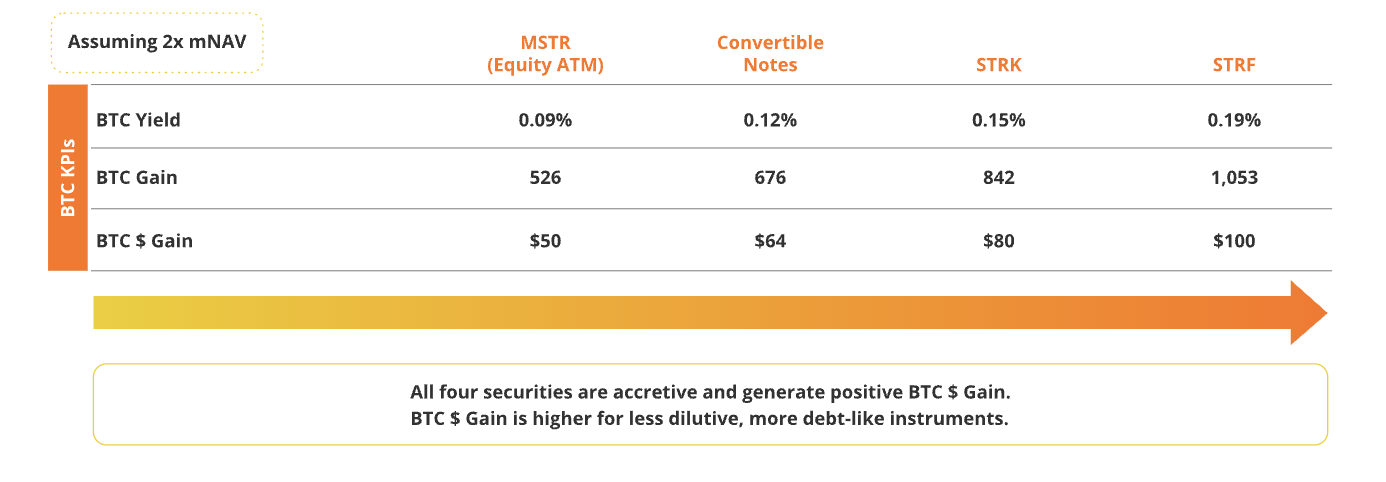
Source: Strategy, as of May 8, 2025. Past performance is not indicative of future results. This article does not constitute buy/sell recommendations for any securities mentioned.
If Saylor does not achieve Strategy's yield target by increasing the number of common shares, he would need to purchase 58,312 BTC, which would cost approximately $5.9 billion at current prices. On the other hand, if he were to increase exposure solely through issuing common stock, he would need to issue about 25.8 million shares to purchase Bitcoin worth 108,305 BTC, costing approximately $10.8 billion at current prices. Given the strong demand in the capital markets for Strategy's capital structure, it is likely that Strategy will easily achieve its 25% yield target for 2025.
High BTC Yield is Difficult to Sustain
**Funds Required to Increase MSTR Yield by Each *Basis Point* (Million USD, 90-Day Moving Average)**

Source: VanEck Research, as of April 11, 2025. Past performance is not indicative of future results. This article does not constitute buy/sell recommendations for any securities mentioned.
The reality facing Saylor's Bitcoin strategy is that high Bitcoin yields are difficult to sustain due to diminishing returns. As Strategy holds more BTC, generating significant additional Bitcoin yield becomes increasingly challenging. This is because, as the total amount of Bitcoin increases, the number of BTC required to generate each additional basis point of yield increases disproportionately.
For example, in August 2021, MicroStrategy only needed 2.6 BTC to generate one basis point of Bitcoin yield. By May 2025, this number had skyrocketed to 58 BTC. From a funding perspective, the amount of capital required to achieve the same unit of yield increased from approximately $126,000 to $5.5 million. This reflects a fundamental mathematical reality: as Strategy's Bitcoin base grows, the marginal contribution of each additional BTC to yield decreases, while the capital required to generate yield grows exponentially. This compounding inefficiency leads to a continually declining ceiling on sustainable yields.
Assessing Strategy's Convertible Bonds
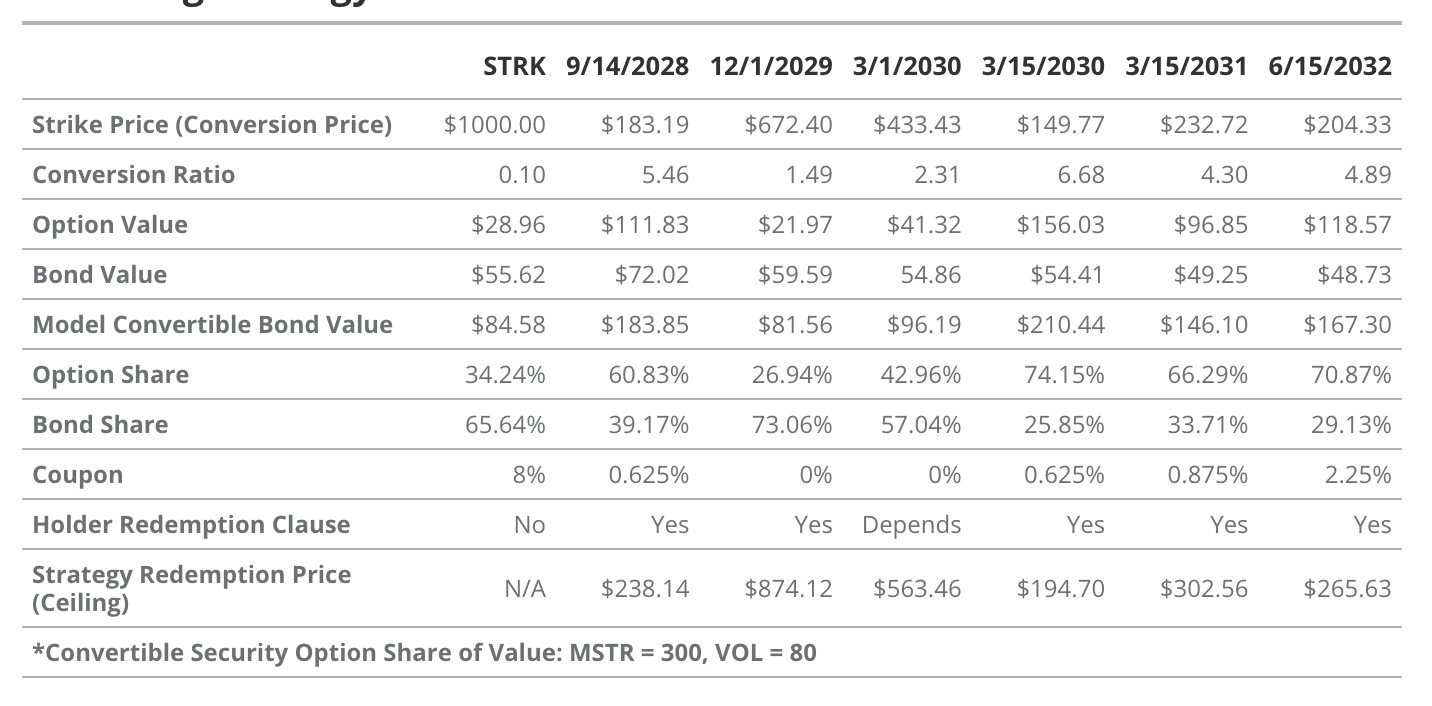
Source: VanEck Research, Strategy, as of April 2, 2025. Past performance is not indicative of future results. The information, valuation scenarios, and price targets in this article are for reference only and do not constitute financial advice, recommendations for any actions, or buy/sell recommendations, nor do they predict Bitcoin's future performance. The actual future performance of Bitcoin is unknown and may differ significantly from the hypothetical results depicted here. Risks or other factors not considered in the scenarios may hinder performance. These are merely research-based simulated results for illustrative purposes. Please conduct your own research and draw your own conclusions.
Convertible bonds are hybrid securities that combine characteristics of fixed income with the upside potential of equity. Specifically, they consist of traditional bonds and embedded call options that allow holders to convert the bonds into MSTR common stock under certain conditions. The total value of convertible bonds equals the value of the bond plus the value of the conversion option. Therefore, investors purchasing convertible bonds effectively allocate part of their principal to corporate bonds and another part to call options. As a result, the price of convertible bonds is sensitive to option pricing variables (such as underlying price, delta, gamma, etc.) as well as bond pricing factors (such as interest rates and credit spreads).
Strategy's convertible notes include special provisions that limit the upside potential of the attached options while providing some protection for investors' principal. Strategy has embedded a "redemption option" that allows the company to repurchase the notes at par plus any unpaid accrued interest after the redemption date. The most common provision in Strategy's convertible bonds is that if MSTR's trading price reaches 130% of the convertible bond's strike price, the company can redeem the bonds. This provision limits the upside value of the bond options after the redemption date. Additionally, except for bonds issued on March 1, 2030, Strategy allows holders of its convertible bonds to sell the bonds back to the company at par after the holder's redemption date, which can be seen as a form of price floor protection for the bonds in the event that Strategy encounters financial difficulties.
The Convertible Bonds Due March 15, 2030 Have the Most Leverage Effect on MSTR Prices Due to Their Large Option Component
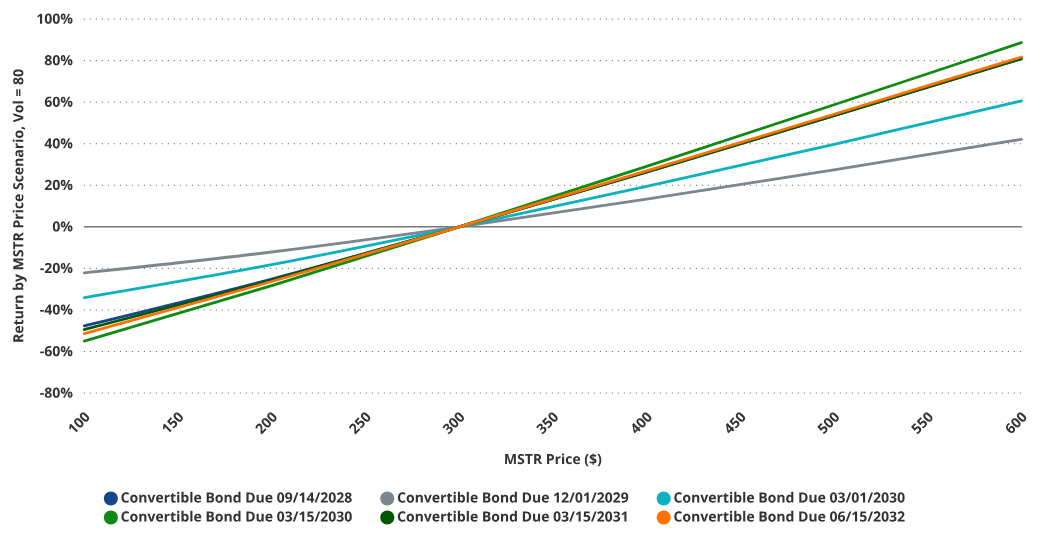
Source: VanEck Research, as of April 2, 2025. Past performance is not indicative of future results. This article does not constitute buy/sell recommendations for any securities mentioned.
Due to the extreme volatility of the underlying stock, MicroStrategy's convertible bonds contain significant embedded option value. Depending on different issuance scenarios, the portion of the total bond value attributed to options can be as high as 74%. The higher this ratio, the greater the investor's exposure to MSTR stock price fluctuations. This exposure can change significantly as MSTR's volatility changes and as options move in and out of the money.
Among all outstanding convertible bonds, the Class B bonds due in March 2030 have risk characteristics most similar to MSTR stock. In high volatility scenarios (e.g., when MSTR's volatility > 80), the sensitivity of this bond to MSTR's price is the highest, regardless of whether the stock price rises or falls. In contrast, the bonds maturing in December 2029 have the lowest sensitivity to MSTR's price, as their embedded options are deeply out of the money. This results in a smaller contribution of the options to the overall bond value, thereby weakening their impact on bond price fluctuations.
Implied Credit Spread vs. BTC-Adjusted Credit Valuation
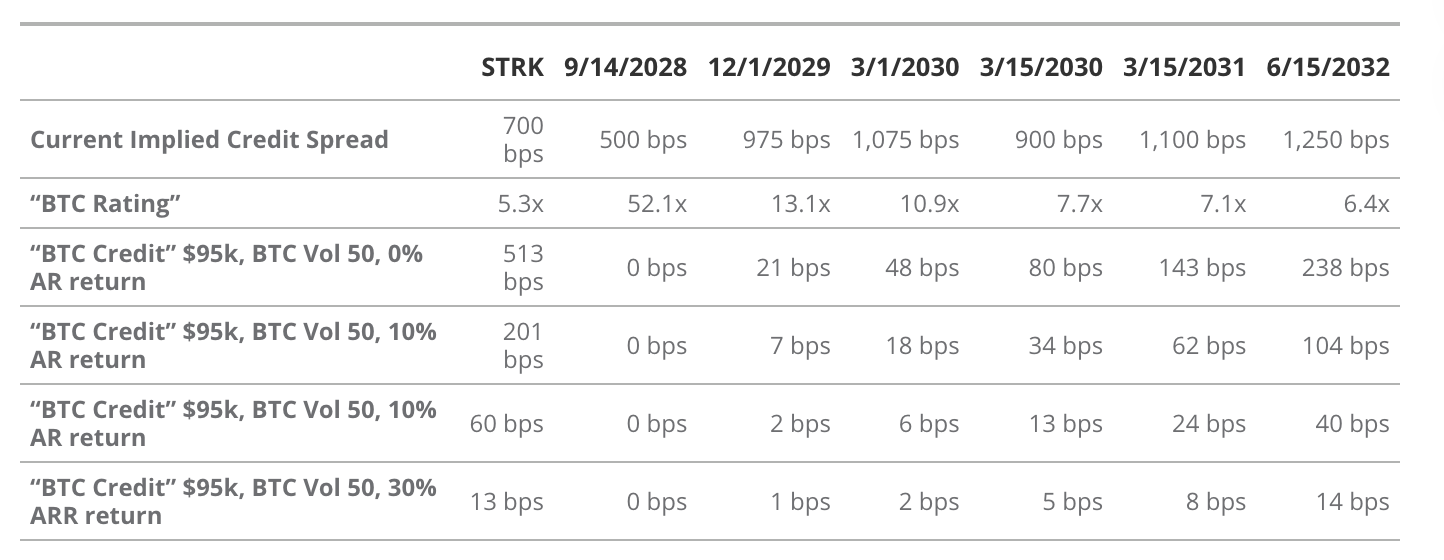
Source: VanEck Research, Strategy, as of May 7, 2025. Past performance is not indicative of future results. This article does not constitute buy/sell recommendations for any securities mentioned.
The bond portion of Strategy's convertible debt is controversial due to its high credit spread. The wide credit spread reflects the market's risk assessment of Saylor's bonds, making these bonds priced relatively "cheap." As Saylor mentioned in the first quarter 2025 earnings call, the credit spreads on Strategy's fixed income securities range from 500 to 1250 basis points. This categorizes Strategy's bonds as "double or triple junk bond credit spreads."
Saylor believes that these credit spreads are so large because the market has not accurately assessed the value supported by BTC collateral. Due to credit rating agencies' failure to adequately evaluate Strategy's bonds, Saylor claims that many long-term investors refrain from purchasing these bonds due to perceived risks. This has lowered the market price of the bonds and resulted in excessively wide credit spreads.
Saylor conducts his own analysis of Strategy's convertible bonds using an options pricing model to demonstrate that these bonds are undervalued due to the collateral value not being fully considered. He introduced the concepts of "BTC Rating" and "BTC Risk" to describe the potential risks of Strategy's debt. The "BTC Rating" is the multiple of Bitcoin holdings to the bond's face value at the current BTC market price. This metric applies to all bonds and is adjusted based on the priority of Strategy's Bitcoin holdings at liquidation. For example, the BTC rating for the bonds maturing on September 14, 2028, is 52.1 times, meaning that at the current BTC price, the value of Strategy's BTC is 52.1 times the face value of that bond.
Saylor combines the "BTC Rating" with the options pricing model to calculate the probability of BTC prices falling below the liquidation price using current BTC prices and volatility, ensuring that bondholders do not incur losses. He refers to this calculated probability as "BTC Risk" and inputs it into the bond pricing model to generate a new "credit spread," which he calls "BTC Credit." As shown in the table above, Saylor believes the market overestimates the default probability for each bond, leading to trading prices below the "reasonable" assessed prices.
Implied Yield of MSTR Convertible Bonds

Source: VanEck Research, as of April 7, 2025. Past performance is not indicative of future results. This article does not constitute buy/sell recommendations for any securities mentioned. All forecasts in this article are based on VanEck's own research and are for illustrative purposes only, valid as of the date of publication, and may change at any time without notice.
A major issue with Strategy's convertible bonds is the significant impact of the embedded option component on their pricing. As a result, many issued bonds currently trade well above their face value, providing some degree of downside protection. In other words, if the option premium weakens, a large portion of the bond's value may decline. For example, as of May 7, 2025, the price of the 2028 convertible bond is $227.15. If MSTR's stock price falls below the bond's conversion price of $183.19 at maturity, the bond's value would only be $100 (assuming other factors remain constant). This reflects the significant option premium embedded in these instruments.
Another significant risk of the embedded options is their sensitivity to changes in option pricing factors such as volatility. We estimate that if volatility drops from 85 to 50, the bond value would decline by approximately (-13%); if volatility further drops from 85 to 30, the average price decline would reach about (-20%).
The performance of MSTR stock is significantly influenced by the "premium," which accounts for 87% of its volatility and 96% of its total returns. We believe this indicates that investors in MSTR convertible bonds are not merely purchasing stock options; they are actually buying options that are expected to maintain a "premium." This premium is primarily driven by Bitcoin prices. As Bitcoin prices rise, the company gains more financing capacity, thereby increasing the expected value of its held assets and supporting market speculation on MSTR stock.
If Bitcoin prices decline, the premium may also decrease. We estimate the beta of this relationship to be approximately 1.77, meaning the value of the premium could significantly decline relative to Bitcoin prices. This decline would erode the value of the option portion in the convertible bonds.
The fixed income portion of the convertible bonds is also affected by the premium. The linear value portion of the bonds depends to some extent on the company's future financing capacity. However, Strategy's income is insufficient to meet its fixed income obligations, let alone repay principal at maturity. If the premium declines, Strategy's financing capacity will weaken, potentially leading to wider credit spreads, thereby reducing the value of the corporate bond portion in the convertible bonds. The primary reason for the decline in the premium may be the drop in Bitcoin prices. Additionally, a decline in Bitcoin prices would also reduce the probability of bondholders recovering full value in a Bitcoin liquidation scenario, further weakening the value of Strategy's convertible bonds.
This bearish scenario is not inevitable but serves to emphasize that both components of convertible bonds—the options and the bonds themselves—are linked to the same underlying drivers: Bitcoin prices and MSTR premiums. While some investors may be able to hedge these risks, many may find it difficult to understand these risks, let alone manage them effectively. MSTR convertible bonds may attract investors seeking yield and potential upside, but they involve many risks. These instruments may be more suitable for mature investors capable of executing dynamic hedging strategies and analyzing debt behavior linked to stocks.
The Rise in Convertible Bond Value Due to Tightening Credit Risk
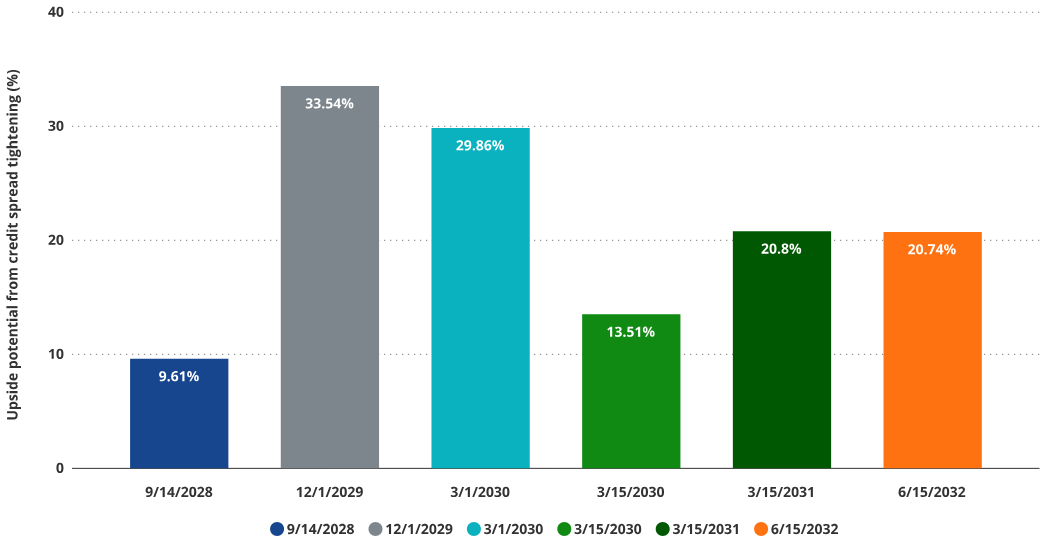

Source: VanEck Research, as of May 7, 2025. All forecasts in this article are based on VanEck's own research and are for illustrative purposes only, valid as of the date of publication, and may change at any time without notice.
Despite the risks, Strategy's convertible bonds provide an exciting tool for the advancement of speculative cryptocurrency accounting practices. If credit rating agencies take a more positive view of Bitcoin as collateral for debt, this could lead to a significant tightening of credit spreads. This would substantially increase the overall value of Strategy's convertible bonds by enhancing the value of the bond portion. If Strategy's bonds reach what Saylor considers the "true" minimum estimate of credit spreads, we calculate that the median value of the convertible bonds would increase by (+16%). In fact, convertible bonds with a higher proportion of bond value may see the largest price increases.
The most attractive targets are the bonds maturing on December 1, 2029 (+31% upside) and the bonds maturing on March 1, 2030 (+26% upside). Given that the bonds maturing on March 1, 2030, are closer to the in-the-money region of the options, the combination of their credit spread converting to the "BTC Credit" defined by Saylor and their high option value may be appealing to brave speculators. However, for traditional long-term investors, the risk exposure embedded in these bonds may be too complex to manage. Relatively speaking, we believe they are less attractive than other parts of MSTR's capital structure.
MSTR Price Simulation (Bitcoin Price Volatility +/- 80%, MSTR Volatility = 80)
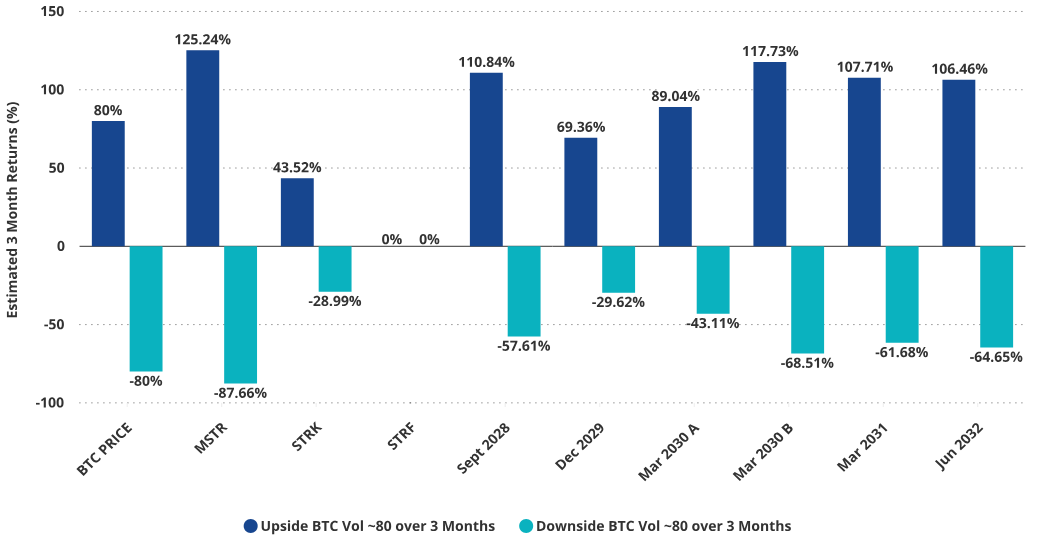
Assuming MSTR volatility is 80, BTC drops 80% over 3 months.
Source: VanEck Research, as of April 2, 2025. All forecasts in this article are based on VanEck's own research and are for illustrative purposes only, valid as of the date of publication, and may change at any time without notice. This article does not constitute buy/sell recommendations for any securities mentioned.
STRK Overview and Analysis
STRK is referred to as "Preferred Perpetual Convertible Equity," integrating multiple concepts into a single security. It offers a perpetual dividend at a face value of 8%, which can be paid in cash or common stock. However, there are restrictions on paying dividends in common stock; for example, if MSTR's value falls below 35% of its price on January 27, 2025 ($347.92), the total number of shares paid in common stock will be limited.
STRK also provides a perpetual MSTR stock option (i.e., the option value does not decay over time) and has liquidation rights typically associated with preferred stock. Similar to convertible bonds but with a lower priority, it is a fixed-income security with a deeply out-of-the-money call option, with a strike price of $1,000, which is 2.5 times the current trading price of MSTR (as of May 7, 2025).
According to our calculations, approximately 36% of the current STRK price comes from the call option, allowing holders to gain exposure to MSTR's upside. Due to MSTR's extreme volatility and the perpetual nature of the option, the option portion of STRK has been trading with a Delta close to 1, even though the option is deeply out of the money. This means that the price fluctuations of STRK are closely related to the price fluctuations of MSTR.
Before MSTR's stock price approaches the conversion strike price, we expect STRK's sensitivity to changes in volatility to exhibit significant asymmetry, skewed to the downside. For example, if implied volatility increases from about 80% to 120%, we estimate that STRK's price will only increase slightly (+0.01%). However, if volatility drops from 80% to 40%, we expect STRK's price to decline by about (-3%), and a further drop in volatility to 20% would result in a loss of approximately (-19%).
The reason for this asymmetric risk lies in the fact that STRK's embedded call option is currently deeply out of the money and perpetual in nature. In this case, an increase in volatility beyond a certain level has little impact on the probability of the option eventually moving into the money, resulting in a muted upside reaction. Conversely, a decrease in MSTR's current volatility significantly lowers the probability of the option moving into the money, leading to a substantial price drop. This convex volatility exposure, limited upside potential, and significant downside risk are key characteristics of STRK's risk profile. In other words, STRK can be viewed as a security that pays for holding a call option, but with more limited upside compared to directly purchasing MSTR.
Asymmetric Decline of STRK Price with Decreasing Volatility

Source: VanEck Research, as of April 7, 2025. All forecasts in this article are based on VanEck's own research and are for illustrative purposes only, valid as of the date of publication, and may change at any time without notice. This article does not constitute buy/sell recommendations for any securities mentioned.
From a pricing perspective, we expect STRK's price movements to significantly weaken compared to changes in MSTR's stock price, whether upward or downward. For example, we calculate that if MSTR's stock price rises (+100%), all else being equal, STRK's price will increase by about (+37%). Conversely, if MSTR's stock price falls (-50%), STRK's value is expected to decline by about (-17%).
However, in a bearish scenario, STRK's credit spread may also widen, which would have a significant impact on the value of its preferred stock portion. For example, if the credit spread increases from 700 basis points by 500 basis points to 1200 basis points while MSTR's stock price declines (-50%), the combined effect could lead to a drop in STRK's price of about (-30%). We believe this scenario is quite likely, as Strategy's credit spread direction often follows MSTR's price fluctuations.
Interestingly, STRK's implied credit spread is closer to Saylor's estimates based on Bitcoin rather than Strategy's convertible bonds. This indicates that, compared to STRK's credit spread converging to Saylor's calculations, STRK has less upside potential.
Strategy's Liabilities and Capital Structure
Assuming a Bitcoin price of $95,000, Bitcoin volatility of 50%, and an annualized return rate of 0% ("Skeptic" scenario).
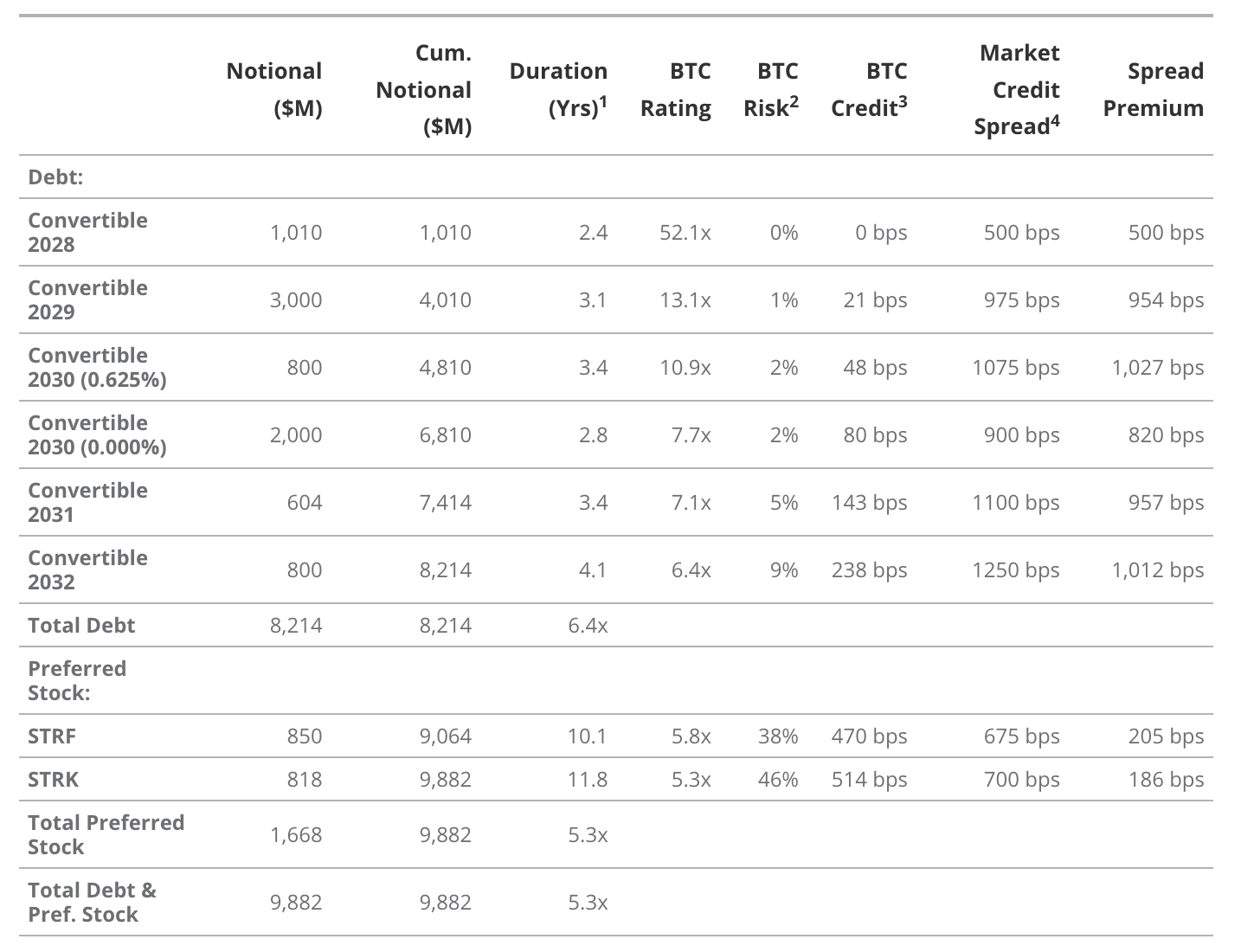
Source: FactSet, Strategy, as of May 7, 2025. This article does not constitute buy/sell recommendations for any securities mentioned.
The duration of convertible bonds is calculated to the redemption date, while the duration of preferred stock is calculated using Macaulay duration.
The log-normal model is used to adjust the annualized return rate of Bitcoin (BTC ARR) and Bitcoin volatility (BTC Volatility) to calculate the probability of BTC rating falling below 1 times within a specific duration.
Assuming the same risk each year and no recovery when collateral is insufficient, the BTC risk is annualized to derive the BTC credit value (BTC Credit = -ln(1 - BTC Risk) ÷ Duration).
Source: Bloomberg and Kynex. Assuming a borrowing cost of 0.50% and volatility of 60% to calculate the credit spread of convertible bonds; assuming the value of the embedded call option in STRK is 200 basis points.
As mentioned above, Strategy plans to issue approximately $20 billion of additional STRK. These future issuances will further increase the claims on dividends generated by Strategy, thereby raising its risk level. Even without additional STRK issuances, Strategy's ability to pay existing dividends in cash seems constrained. STRK's position in the capital stack is even lower than that of Strategy's convertible bonds, leading Saylor to rate STRK's Bitcoin risk (BTC Risk) as significantly higher than that of convertible bonds. In Strategy's baseline assessment (assuming Bitcoin prices do not rise), the probability that the value of Bitcoin held by Strategy falls below the implied support of STRK within a year is 46%.
We believe that several structural characteristics of STRK present significant downside risks without corresponding upside potential. These characteristics include weaker Bitcoin support capacity, the possibility of suspending dividends, and a smaller option portion in the bonds. Additionally, the price appreciation potential from the re-rating of STRK's credit spread is also very limited.
Therefore, we believe that STRK's risk-reward ratio is not ideal for long-term investors, especially compared to the risk-reward ratio of MSTR stock. However, for active investors who can skillfully hedge STRK risks, its volatility and dividend characteristics may be attractive. Yield-oriented active investors looking to gain some upside potential from MSTR stock may find STRK appealing. Furthermore, long-term bullish investors in Strategy may find STRK more attractive, as its option portion has a Delta close to 1 while also providing an attractive yield.
STRF Overview and Analysis
STRF is a simple preferred stock instrument that offers a fixed cash coupon of 10% per year. Unlike STRK, STRF cannot pay dividends in common stock. Currently, STRF is trading at $94.30, with an effective annual yield of approximately 10.6%.
The valuation of STRF is primarily driven by current interest rates and Strategy's credit spread. According to the terms of the agreement between Strategy and STRF holders, each time a dividend payment is missed, the coupon rate will increase by 100 basis points, up to a maximum of 18%. If dividends are missed four consecutive times or a total of eight times, STRF holders have the right to elect one director to Strategy's board. This right will be revoked once all missed dividends are paid. STRF has a higher priority in the capital structure than STRK and MSTR common stock, providing stronger claims in liquidation. However, its support capacity is weaker, with a Bitcoin rating of 5.8 times, compared to STRK's 5.3 times.
Considering that MSTR has not generated significant cash flow since 2021, these protections are somewhat meaningful, but given Bitcoin's volatility, they remain relatively weak. If MSTR's core business further deteriorates or the company loses its ability to raise funds in the capital markets, dividend payments may be suspended. In such a case, STRF would resemble a long-term subordinated bond with significant credit risk but no equity upside potential. If this event coincides with a drop in Bitcoin prices (a possible scenario), STRF's value would be significantly impacted.
The biggest challenge for STRF is that it cannot benefit from Bitcoin's rise while being exposed to the risk of a significant drop in Bitcoin prices. A decline in Bitcoin prices may weaken Strategy's ability to meet cash obligations, leading to a widening of its credit spread. This view is supported by empirical evidence, as STRF has a correlation of 50% with MSTR and 55% with Bitcoin. Based on current market prices, STRF's credit spread is approximately 6.1%. If this credit spread approaches the median of convertible bonds at 10.25%, STRF's value would decline by about (-28%). Similar to STRK, STRF is also highly exposed to the impacts of Bitcoin prices and MSTR premiums.
We believe that STRF's risk characteristics are not ideal for long-only investors, as it has limited upside potential and faces unpredictable risk factors. However, for very sophisticated investors, STRF's risk characteristics may be ideal, as these investors can use STRF's dividends to purchase Bitcoin options for some upside exposure or to provide downside protection.
Summary of Strategy's Capital Structure
Strategy's capital structure is highly dependent on the following factors:
Bitcoin prices
Strategy's ability to raise more funds to purchase Bitcoin
The price volatility of Bitcoin and MSTR
MSTR provides an asymmetric investment opportunity that combines leveraged exposure to Bitcoin, compliance, and liquidity in the public market. Despite a complex capital structure and significant risks, MSTR is designed to offer investors a unique tool to participate in Bitcoin's upside through leverage and strategic selectivity that is difficult to replicate. For investors who cannot or do not wish to hold Bitcoin directly or manage futures strategies, MSTR is a more practical and effective alternative. Ongoing investor confidence, stable access to capital markets, and rigorous execution remain key to maintaining this investment logic.
Recommendations for Enterprises Considering Bitcoin Financial Strategies
From a strategic perspective, Strategy offers the following key insights for enterprises considering implementing Bitcoin financial strategies:
Clear Strategic Objectives: Adopting a Bitcoin financial strategy must have a clear goal. The case of Strategy shows that its core objective is to increase the per-share Bitcoin holdings rather than adhering to traditional financial metrics (such as dilution effects or enterprise value in fiat currency). Under Michael Saylor's leadership, the company has realigned its valuation framework around Bitcoin itself. Saylor defines success as the amount of Bitcoin represented by each share of MSTR, rather than returns measured in dollars. This clarity of purpose allows for consistent and long-term decision-making amid market volatility.
Structured Financing Strategy: Enterprises need to develop a financing strategy that fully leverages market dynamics to support Bitcoin accumulation. Strategy successfully attracted market funds by capitalizing on investors' preferences for volatility and embedded options. Saylor built a financial ecosystem that attracts retail investors and active traders through convertible bonds, preferred stock, and common stock issuances. The volatility of Bitcoin transmits to the volatility of MSTR, thereby sustaining market demand for its securities. For example, the open interest in MSTR stock options ($9.5 billion) exceeds that of GOOG and AMZN (at $8 billion and $8.4 billion, respectively), even though GOOG's market capitalization is 15 times that of MSTR. This "flywheel effect" enables Strategy to finance Bitcoin purchases on favorable terms while reducing cash obligations and avoiding complete reliance on traditional debt or equity issuance.
Creating Market Demand: Enterprises must recognize that market demand for Bitcoin-related securities does not form automatically. Investor engagement, innovative structural design, and transparent communication are crucial. Whether through traditional issuances, structured products, or the integration of digital assets, enterprises need to design financial instruments that can provide returns and/or significant upside potential to attract capital. Given the contradictions between Bitcoin financial strategies and traditional financial theories, enterprises need to establish an unassailable investment narrative to support their Bitcoin strategy. Michael Saylor's high-profile public persona is not coincidental; it indicates that the market needs to have confidence in Bitcoin financial strategies to succeed.
Main Risks of Strategy's Bitcoin Financing Model
Strategy's Bitcoin accumulation strategy and MSTR's valuation may face the following macro, structural, and execution risks:
Decline in Bitcoin Prices: Strategy's business model relies on the appreciation of Bitcoin. A sustained decline in Bitcoin prices may weaken the value of existing holdings and affect the feasibility of future financing.
Reduced Volatility of Bitcoin or MSTR: Lower volatility may decrease investor interest in MSTR's convertible bonds and preferred stock, which rely on volatility to attract capital.
Collapse of MSTR Premium Relative to Net Asset Value (NAV): The market premium is key to MSTR's upside potential and ability to issue value-added equity. A sharp contraction in the premium would weaken its fundraising capacity and shareholder returns.
Deterioration of Core Business Operations: Although the importance of the core software business is gradually diminishing, it still contributes to cash flow. Further deterioration would limit financial flexibility during market downturns.
Regulatory Changes Allowing Leveraged Bitcoin Products: Newly launched leveraged Bitcoin ETFs or structured products may reduce investor demand for MSTR as a Bitcoin proxy.
Competition from Imitating Strategies: New companies adopting similar Bitcoin financial models may dilute investor interest and saturate capital market demand for leveraged Bitcoin exposure. Emerging competitors, due to their smaller scale, may achieve higher Bitcoin returns and per-share Bitcoin holdings with less capital.
Forced Liquidation to Meet Debt Obligations: In severe market downturns or financing shortages, Strategy may be forced to sell Bitcoin holdings to repay debts, negatively impacting per-share Bitcoin holdings.
Weakening Demand for Strategy Securities: Strategy plans to raise over $22 billion to continue purchasing Bitcoin. If investor demand declines, its ability to execute its plans will be affected.
Dilution of Per-Share Bitcoin Holdings: For example, issuing new shares to meet dividend or financing obligations may reduce per-share Bitcoin holdings, thereby weakening Strategy's core key performance indicator (KPI): Bitcoin yield.
Instability in Capital Markets: MSTR's business model relies on continuous access to well-functioning and liquid capital markets. Market disruptions may threaten its operations and financial expansion.
Rising Interest Rates: Higher interest rates will increase the cost of debt issuance and reduce investor interest in low-yield convertible bonds, thereby limiting Strategy's ability to finance Bitcoin acquisitions.
Disclaimer Providing links to third-party websites is for convenience only; inclusion of these links does not imply our endorsement, approval, investigation, verification, or monitoring of their content or information. By clicking on a non-VanEck webpage, you acknowledge that you are entering a third-party website that is governed by its own terms and conditions. VanEck is not responsible for the content, legality, or appropriateness of third-party websites.
免责声明:本文章仅代表作者个人观点,不代表本平台的立场和观点。本文章仅供信息分享,不构成对任何人的任何投资建议。用户与作者之间的任何争议,与本平台无关。如网页中刊载的文章或图片涉及侵权,请提供相关的权利证明和身份证明发送邮件到support@aicoin.com,本平台相关工作人员将会进行核查。




